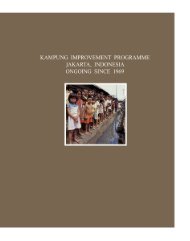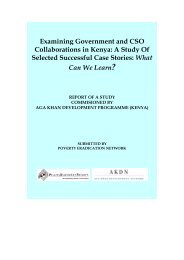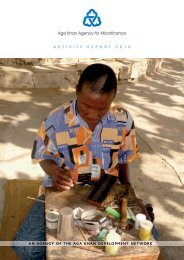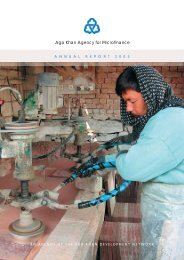The Non-Profit Sector in Kenya - Aga Khan Development Network
The Non-Profit Sector in Kenya - Aga Khan Development Network
The Non-Profit Sector in Kenya - Aga Khan Development Network
- No tags were found...
You also want an ePaper? Increase the reach of your titles
YUMPU automatically turns print PDFs into web optimized ePapers that Google loves.
that this is the period when a new government came to power, it ispossible that the growth was the result of a new political environment.Expla<strong>in</strong><strong>in</strong>g growthSeveral factors account for the growth of NPOs <strong>in</strong> <strong>Kenya</strong>. First is thecountry’s rich tradition of philanthropy and volunteerism, with roots<strong>in</strong> the communal relationships of an African society. Harambee (pool<strong>in</strong>gtogether of resources to provide basic services) is an expression ofthis tradition and the spirit of volunteerism. This tradition has valuesthat are the foundation of non-profit <strong>in</strong>itiatives <strong>in</strong> the country today.Secondly, until very recently, the capacity of the state to provide basicservices has been on the decl<strong>in</strong>e ow<strong>in</strong>g to sluggish economic growth.When growth was high <strong>in</strong> the 1960s and 1970s, <strong>Kenya</strong> had a developmentalstate that was at the centre of service provision. Poor growth <strong>in</strong>the 1980s and donor conditionalities occasioned the <strong>in</strong>troduction ofStructural Adjustment Programmes. <strong>The</strong>se subsequently reduced thegovernment’s ability to provide services. NPOs filled the gaps <strong>in</strong> serviceprovision throughout the 1990s.Thirdly, though not <strong>in</strong> relation to all the different k<strong>in</strong>ds of non-profits,poor economic management and governance resulted <strong>in</strong> donorsshift<strong>in</strong>g their attention and <strong>in</strong>creas<strong>in</strong>g fund<strong>in</strong>g to NGOs from the early1990s. Increased disbursements through NGOs led to the mushroom<strong>in</strong>gof NGOs, who <strong>in</strong> turn used local community organisations as theirentry po<strong>in</strong>t for development work at the grassroots. This resulted <strong>in</strong>proliferation of organisations <strong>in</strong> the development space.F<strong>in</strong>ally, the com<strong>in</strong>g to power of a new government <strong>in</strong> 2003 evolved anew political environment for registration of organisations. <strong>The</strong> highnumbers of Foundations, Trusts and Self-help Groups were registeredespecially dur<strong>in</strong>g the 2003-2004 period.Chapter 2 Growth of <strong>The</strong> <strong>Non</strong>-<strong>Profit</strong> <strong>Sector</strong> <strong>in</strong> <strong>Kenya</strong> 7
















